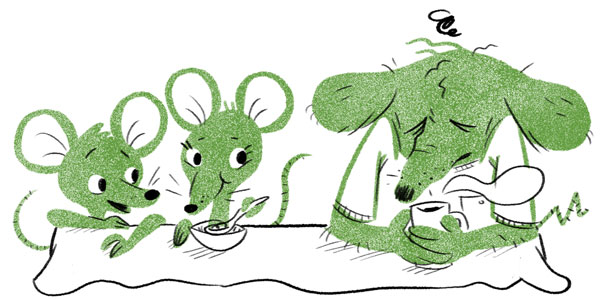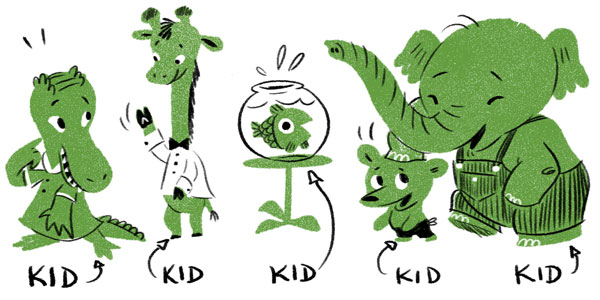Think back to your favorite children’s stories, and likely as not, the main character is an animal. Animals have been made to stand in for human situations for ages, from Native American stories to German fairy tales to Asian mythologies and beyond. Contemporary stories are still filled with animals — one of this summer’s most popular movies included a talking raccoon, and Hello Kitty made headlines recently when her creators at Sanrio said she was not actually a cat, but instead a girl in a “cat motif.” OK, sure.

So, why do so many stories, especially those made for children, use drawings of animals to represent children and people? There are scholarly papers that delve into this topic in a more empirical way, but my assessment is more anecdotal, using my personal experience as a reader and writer as my guide.
In the most general terms, I think animals are innately appealing. They are familiar, caring for their young in a way that is comforting and reaffirming of a child’s worldview. But they are also mysterious, hiding away from us, living in dens, nests and deep in the woods or the ocean and behaving in ways that are surprising and strange from time to time. An animal’s similarities connect us to them, while the differences peak our innate curiosity and keep us interested.

Not to mention that young animals, like young humans, are far cuter than their adult counterparts, generally speaking. Just ask my kids how cute I look at 6 a.m., before coffee.
Animals being animals, mostly
In fables and myths, an animal’s more animal-like behaviors can act as a shorthand for human behaviors to teach us a moral lesson. In Aesop’s The Ant and the Grasshopper, the ants are fastidiously storing away food for the winter, while the grasshopper sings and plays and enjoys the summer. In the short term, the ants’ behavior looks boring and stuffy, while the grasshopper is having a grand old time. But of course, once winter arrives, the grasshopper is without food or shelter, and suffers the consequences of his summer of play, while the ants are safe, warm and fed inside their well-stocked home.
 The Ant and the Grasshopper via Wikipedia
The Ant and the Grasshopper via Wikipedia
The parallels to human behavior are clear to any reader of any age, but because the story is told about ants and grasshoppers, nobody feels directly implicated or scolded. Rather, the animal characters give us the benefit of an outsider’s perspective, and we can digest the lesson more objectively.
Animals being people-like animals
In Roald Dahl’s Fantastic Mr. Fox, we see further anthropomorphized animals — Mr. Fox and his friends wear clothes and walk upright like people, where the ants and grasshopper, though they spoke, still behaved essentially like insects. In Mr. Fox’s case, the animals are only sort of animals. They have families like people do and they have human needs and desires. However, the animal-like behaviors, such as Mr. Fox’s burrowing and poultry-stealing, sets up a wonderful human vs. animal dynamic for the story, and still separates us from their world a bit.

In a story like this, we can put ourselves into the characters’ shoes a bit more, and we can connect with the story more personally than with a fable. The characters are more developed and more human, and the things they do feel more directly familiar than the relative preachiness of the fable’s animal characters. Even though there are actual human characters in the story, we identify with the animals here instead of the people — not because they are animals, per se, but because they are set up as the heroes of the story.
Animals in place of people
One final step away from animal behaviors brings us to James Marshall’s George and Martha, or Arnold Lobel’s Frog and Toad. Like the fables, all human interaction is gone again, but so is the idea of these characters being true animals. George and Martha are only hippos in their shape — they do nothing in the way a hippo would. They are fully “people” rather than just anthropomorphized critters.

In stories like these, the storyteller is using animals in place of children for their broad appeal, and for the neutralization of cultural biases. Gone are the grown-ups’ lenses of race or class or other stereotypes. Now we are just looking at stories about friendship, shared adventure and a childlike perspective on the world.
So, why do we see so many animals in children’s stories? Because they are cute and fuzzy, sure. But also because they are enough like us that we can learn from their behaviors. They are also enough different from us that we can allow the story to unfold without wondering how gender roles are supposed to function in a beaver’s household (lodgehold?) or wondering if a cow’s 300-year-old persecution of ducks still affects the cattle/waterfowl dynamic in today’s playground hierarchy.
No. Instead they are just kids, and we can understand those interactions for what they are — kids being kids.

Share tips, start a discussion or ask one of our experts or other students a question.
No Responses to “Release Your Inner Animal by Illustrating Books With Animal Characters”